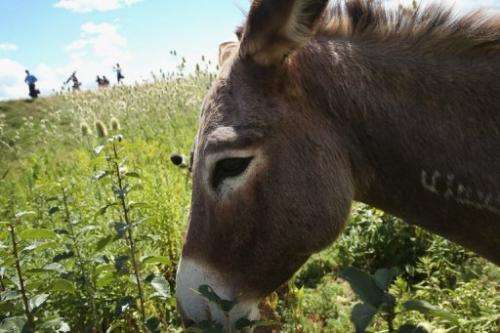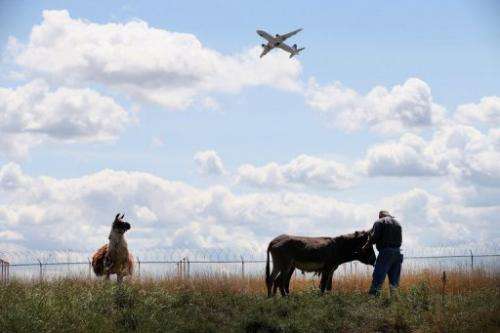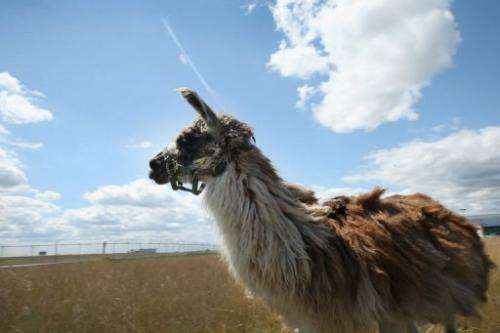Llamas and goats keep grass cut at Chicago airport

Chicago's bustling O'Hare airport has hired a new crew to keep the grass cut: a herd of goats, sheep, donkeys and llamas. Yes, llamas.
The llamas help protect the sheep and miniature goats from coyotes that roam the wooded areas near one of the world's busiest airports. The donkeys are also big and aggressive enough to keep predators away.
And the entire chew crew works to keep the grounds clear of critters that can interfere—or even endanger—airport operations.
Long grass isn't just messy, airport officials explained as they unveiled the new crew Tuesday. It's also a breeding ground for the small rodents that attract hawks and other birds of prey.
"Birds and planes don't mix," said Rosemarie Andolino commissioner of Chicago's airport authority.
Chicago used to rely on herbicides and motorized lawnmowers to maintain the nearly 8,000 acres (3,200 hectares) of land surrounding O'Hare.
But the rocky and hilly areas far from the tarmacs were tough to mow and could damage the city's expensive equipment. And despite endless hours of hot sweaty landscaping work, the airport's wildlife relocation team was constantly on the hunt for errant animals.

So the Windy City decided to follow the lead of airports in Seattle, San Francisco and Atlanta and try an old-fashioned approach.
Aside from giving the landscaping crew a break, relying on ruminants also potentially reduces the airport's carbon footprint by eliminating the use of gasoline-powered equipment.
It's not yet clear how much of an impact the herd of 14 goats, six sheep two llamas and three donkeys will make. It can't be allowed anywhere near the tarmac and also has to be protected from the busy freeway and roads that line the airport grounds.
Airport officials identified about 120 acres in four fenced-in sites that are choked with the kinds of grasses and weeds that can keep the herd happily munching for months.
They plan to monitor how long it takes the herd to clear each section. If it works well, they could even expand the herd to include more animals and a wider grazing area, Andolino said.
A local restaurant—which keeps its own goats for cheese—has partnered with an animal rescue group to manage the herd at a cost of $19,000 for two years.
"It's a very inexpensive project," Andolino said.

The airport's firefighters drive fresh water over for their water trough and a crew of minders corrals the herd in and out of a trailer that acts as a temporary barn for the evenings.
When it gets too cold for them to graze, the herd will be transferred to a warmer winter home.
The animals don't seem bothered at all by the roar of the airplanes as they take off and land overhead, said Pinky Janota of the Settlers Pond animal shelter.
"We had a little lamb born this morning," she said. "He's doing great, suckling on mom with planes going overhead. He didn't flinch."
They named him O'Hare, naturally.
© 2013 AFP




















